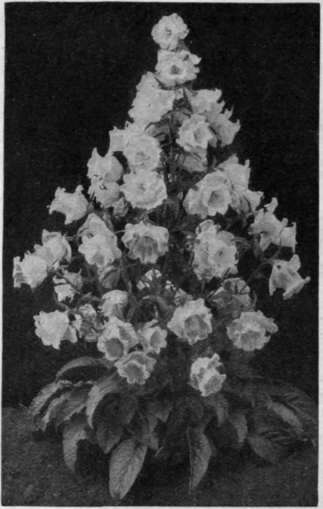17. The Garden
Description
This section is from "Every Woman's Encyclopaedia". Also available from Amazon: Every Woman's Encyclopaedia.
17. The Garden
The Conservatory And Greenhouse
Camellias will need plenty of watering and feeding this month, as well as an occasional dose of soot-water. Keep the foliage green by syringing.
Arum lilies that are going over should be encouraged to complete their growth, and given a little liquid manure and soot-water. They should stand in a warm position out of doors, or in a cool house. When the foliage begins to wither, water should be withheld. After a short period of rest they may be repotted.
Sow seeds of cineraria and primula, and see that the pans are well drained with plenty of crocks. Water the soil for cinerarias before sowing, but that for primulas should be fairly dry. Press the seeds gently into the pans with a piece of board. Some very beautiful specimens of primula can be raised from seed.
Keep carnations healthy, and feed when needful, giving plenty of water, but not too much. The plants may stand in a cold frame during the summer, but Malmai-son varieties must not be exposed to rain, or the leaves may be attacked by fungus.
Cyclamens must be kept clean. Shift the young plants into their flowering pots, using a good compost of, say, turfy loam, leaf mould, sand, and a little soot.
Fuchsias and other young plants requiring it may be shifted into larger pots. Inside borders must be kept moist, and plants in pots must be watered constantly, liquid manure being given to plants in need of it.
Lights may remain open night and day, and as much air should be given in the daytime as possible. Remove superfluous stock, where possible, to the open air, as this will give more room inside the greenhouse.
The Stove And Forcing-House
Great attention must be paid to keeping out pests. Fumigate the moment thrip or greenfly appear, and sponge with soft-soap for mealy bug. Thrip and greenfly are particularly fond of smooth-leaved plants, such as gardenias and crotons. Stove climbers should be trained, tying the shoots up near the glass.
Plants and shrubs which have been used

The "cup and saucer" variety of the Canterbury bell, a beautiful biennial that is sown in June
Copyright, Sutton & Sons for forcing should be placed out of doors to ripen their wood. Remove the lights from the rose-house if possible, as this will help to give the plants a thorough rest.
The Vegetable Garden
The latest crops of broad beans may be sown this month. Soak the seeds and water the drills if the weather is very dry. Plants in full bloom may be topped, and the stems of later plants slightly moulded up. Dwarf French and runner beans may be sown for an autumn crop.
Thin out carrots without delay, hoeing and watering both before and after doing so. Thin out lettuce, turnips, and radishes as required. The thinnings of radishes are excellent for salad. Make a fresh sowing in a cool, moist situation, and a main sowing of turnips. Sow lettuces for a succession, and endive for autumn use.
In preparing the ground for planting celery, take out trenches about 2 feet 6 inches across, piling the soil neatly on either side; then fork in a three-inch layer of old manure, and tread the whole down lightly. Put in the young plants, six inches apart, the rows being either single or double. In the latter case the trenches should, of course, be considerably wider, and fifteen inches should be allowed between the rows.
Celeriac should have its suckers and lowest leaves removed this month. Keep the roots aerated by hoeing, and give sufficient water. Plant out leeks, if this was not done in May. Peas should be sown for a late crop, putting them in rather more thinly than the early'kinds. If the soil is dry, they may be sown in a shallow trench, drawing the soil up around them if drought is threatened. Stake the earlier crops as they come on.
Winter Greens
Strong plants of Brussels sprouts, broccoli, and kale can be put out at the end of the month, fifteen or eighteen inches apart in the rows, which should be eighteen inches or two feet asunder. These crops may be planted between potatoes if space is scarce; but the ground should be well drained, and in an open position.
Continue to:


